
- POWER BINDERS
- FOR '64-'67 NOVAS
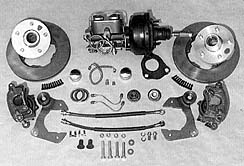
- The new disc brake kit from Classic Performance
Products, comes with giant 11-inch rotors, lightweight custom aluminum
hubs, Timken roller bearings, single-piston calipers, caliper mounting
brackets, seven-inch booster master cylinder, proportioning valve/bracket,
stainless hard lines, brake hoses, and necessary hardware. Engine compartment
cross-over line and rear brake hard line are optional. Also, all parts
can be ordered separately.
|
So how's your early to mid '60's Nova stopping these days?
Not too bad, you say, but sometimes not too good? Small wonder, since those
factory drum brakes are, at best, okay, but time and mileage will definitely
reduce the standard shoe and drum's reliability, especially up front. For
example, most who've owned a'62-'67 Nova have probably experienced fade
as well as a great deal of wandering under panic stop conditions. This is
where front disc brakes, which were offered as an option on 1967 Novas,
can make a tremendous difference in the stopping power of these increasingly
popular machines. Power binders definitely help get the car stopped quicker
and assuredly straighter. Because of the more efficient stopping power
of a front disc brake/rear drum arrangement, a few after market Manufacturers
have come up with their own kits to retrofit early Novas that didn't have
or come with the option. Most kits require removal of the spindles so they
can be machined to accommodate the calipers, and most move the wheels outward.
But not these from Classic Performance Products. When we heard that
Jim Ries (proprietor of the Buena Park, California firm, which manufacturers
Chevy and Ford truck disc brake kits) was venturing toward the passenger
car line ('55-'57 Chevy, to be exact), we asked him if he would consider
a kit for the '62-'67 Novas. Fortunately, we must have been on the
same brain waves, because he immediately stated that, "Early Novas
are what's happening, and so are disc brakes.
|
"Since the '62 and '63 models have a different size
wheel bearing/spindle diameter, and the '64-'67's seem to be gaining in
popularity (and their spindles are identical), Jim decided to prototype
a kit for the latter and we were there to look in on how it all went together.
Also, for this application, the donor car's 14 x 6 American Racing Torq-Thrust
aluminum mag wheels were a concern for caliper clearance, but Ries assured
us that his kit would work just fine. First thing on the agenda was
the booster and master cylinder. Jim removed the original master cylinder,
and unbolted the steering column/master cylinder brace so as to remove the
pair of studs in the heavy-duty bracket. Then the brace for the new power
booster was installed under the dash. Jim originally wanted to use a factory
power booster, but was having difficulty locating one (not to mention the
fact that when a unit finally showed up, the master cylinder he planned
on using was too long, causing interference problems with the shock tower
and inner fender). Therefore, Jim decided to implement "Plan B,"
which meant using a new, smaller (7-inch diameter) and narrower booster.
It was a tight fit, but this combination cleared. And to make things easier
for the do-it-yourselfer, the setup Comes with the booster, master cylinder,
proportioning valve, and hard lines as an assembled unit. By the way, all
hard lines are pre-bent stainless steel, definitely a bolt-in situation.
There are two lines that do not come in the kit, but are optional order
items.
|
One goes from the proportioning valve to the rear drum
brakes; luckily for '67 owners, that line is already there, thanks to the
stock dual master cylinder, and driver-side routing. The other is the engine
compartment line, also stainless, that routes between the two inner fender
fittings. For '64-'66's, the rear brake line is eliminated and the
T-fitting (on Passenger side inner fender) is plugged at its rear line junction.
At the spindle end, all that's needed to convert from drum to disc is a
few hand tools and a grinder to remove a couple of bosses on the GM single-piston
calipers. After removing the stock brakes, and wiping off old grease and
road grime from the spindle, make sure each spindle is in excellent condition.
In other words, look for any bearing wear that may have cut into the spindle.
If so, a good spindle must be used before attempting the conversion.
This kit utilizes a custom aluminum hub and rotor combination, held together
with high-strength cap screw bolts (Loc-Tite recommended), and features
Timken roller bearings. Also, a custom steel caliper/spindle bracket
bolts to the OEM spindle, and uses a spacer between the steering arm and
spindle. With the bearings greased, and dust seal in, the new rotor
can easily be slid into place, then the spindle nut tightened correctly,
and a cotter pin installed. Before the calipers can go on, however,
two bosses must be ground down for the required clearance. Once this is
done, calipers can be mounted, and so can brake hoses (with banjo fittings)
and the short hard lines to inner fender fittings. That's about it
bolt on the wheels (in this case, the 14x6 Americans cleared just enough),
bleed the brakes, and be happier knowing your Nova will stop much, much
better!
|
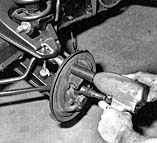
With car on jack stands, and with the wheels off, it's
a simple matter of removing the stock drum Brake components, including the
backing plate, shown. To take off the backing plate, top bolt (into
spindle), and two lower bolts/nuts (securing steering arm) must first be
removed.
|
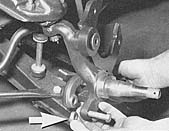
Once the spindle is exposed, and cleaned of all grease,
it's the perfect time to check for any excessive wear in the wheel bearing.
If so, the spindle must be replaced before this disc brake conversion can
continue. Note simple Bolt-on of caliper bracket to the spindle's two existing
mounting points. Also notice short spacer (arrow) used between spindle 's
front boss and steering arm.
|
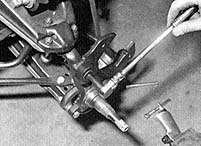
After the specially tapered socket-style Allen bolt (at
top), and two new lower 7/16-inch bolts and nuts have been started, they
can all be tightened. 3/8-inch Allen wrench, and recommended Loc-Tite adhesive
sealant, is used for top bolt only; no sealant is necessary for two lower
bolts, as Nylock nuts are supplied.
|
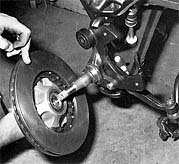
Rotors and hubs come unassembled, but it's an easy bolt-together
situation here as the pieces are mated via a handful of 3/16-inch Allen
bolts (10, to be exact). Again, Loc-Tite is a great idea, just to make sure.
Assembled rotor/hub can now be fitted adequately greased Timken bearings/dust
seal, then unit can be slipped onto spindle, followed by tightening of spindle
nut over washer and outer wheel bearing.
|

Since this was a prototype, we took measurements with
the stock drum brakes, and then with the new discs, to see how much each
wheel surface would move outward. Make that inward in this case, a substantial
1/8-inch.
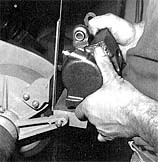
Before each caliper can be mounted, a center boss must
be ground flush in order to clear the new caliper mounting bracket.
|

There's also another small part of the caliper which must
be ground away. This time, it's located at the brake hose area (arrow).
This is done so the new banjo-fitted brake hose can be properly angled,
and not interfere with the spindle.
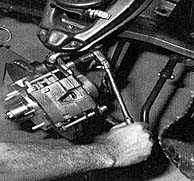
It's Loc-Tite time again, for the caliper bolts that secure
the caliper assembly to the custom caliper mounting bracket. A 3/8-inch
Allen wrench is called on here.
|
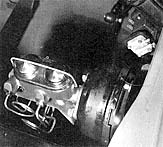
Jim Ries did his homework to come up with a booster/master/proportioning
valve setup that would clear the Nova's shock fewer inner fender. As you
can see, the plumbed assembly fits like a glove. The 7-inch Booster is coupled
to a new 1-inch bore master cylinder, and a custom bracket supports a Delco
proportioning valve, with all stainless lines.
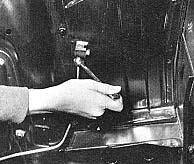
On '64-'67 models, the stock rear brake line is routed
from passenger-side fitting, just Behind shock tower's inner fender.
For this application, Ries eliminated the stock line by capping on the fitting,
and ran a new (optional) stainless steel cross-over line, between fire two
inner fender fittings.
|
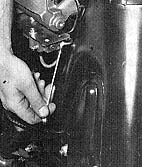
As you can see, it's a close fit between master cylinder
assembly and inner fender, but it does clear. Also, fire hard
line (shown being tightened with 3/8-inch wrench), that goes to driver-side
inner fender fitting, can still be removed.
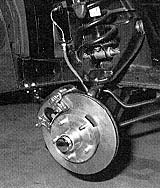
Here's the finished disc brake setup for the passenger-side
wheel. In this instance, we got a bonus as we discovered that 14x6
American Racing Torq-Thrust "mag" wheels cleared the calipers.
Now we can rely on stopping this '66 Nova much quicker and straighter than
the previous factory drum setup.
|
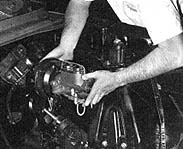
Talk about a sanitary installation of the Booster/master
cylinder setup, it looks Better than a factory installation. Note neat wrap-around
stainless steel hard line (optional) from proportioning valve to rear drum
brakes. Complete disc brake kit part number is CPP-6467-DK.
|
|
| Classic Performance Products 378 E Orangethorpe
Ave., Placentia CA 92870 Tech Line 714-522-2000 |
 |
TECH
| BOOKS | SUSPENSION
| BRAKES | STEERING | CONTACT
US | HOT PRODUCTS |

|
| © Classic Performance Products. This "website"
and all contents are property of Classic Performance Products.
Prices subject to change without notice. Not responsible for
errors or omissions. Please note that kits & prices
may vary between certain applications. |
|
|
|
|
|
|
|